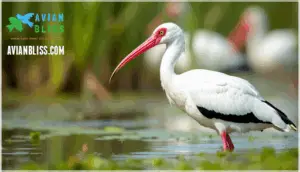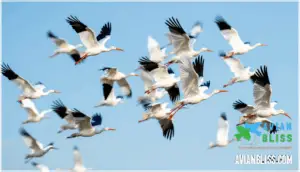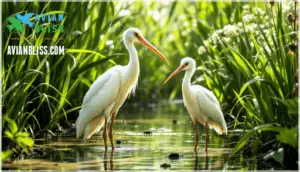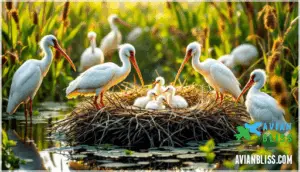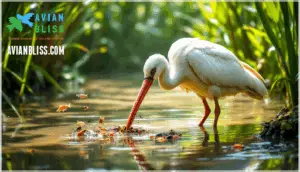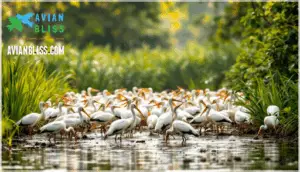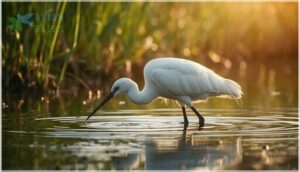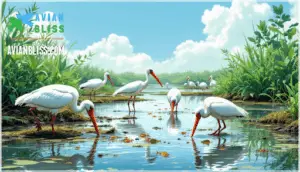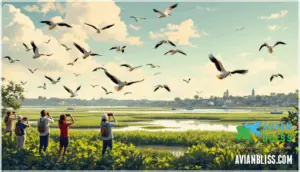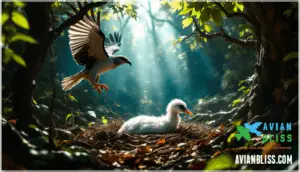This site is supported by our readers. We may earn a commission, at no cost to you, if you purchase through links.
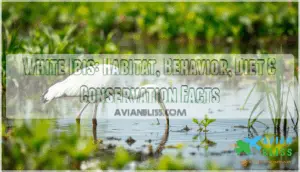
From coastal marshes to suburban lawns in southern Florida, white ibises have adapted to changing landscapes in ways that surprise researchers. Their success lies in flexibility: probe muddy swamps for crayfish one day, scavenge park scraps the next.
As wetland habitats shrink and shift, understanding how these birds survive—and thrive—matters more than ever. Their story reveals lessons about adaptation, ecosystem health, and what it takes to coexist with humans.
Table Of Contents
- Key Takeaways
- Habitat and Range
- Physical Description
- Reproduction
- Food Habits
- Behavior and Lifestyle
- Conservation Status
- Ecosystem Roles
- Economic Importance for Humans
- Predation and Mortality
- Interesting Facts and Trivia
- Frequently Asked Questions (FAQs)
- What are white ibis eating in my yard?
- Why are white ibis protected in Florida?
- Can you shoot white ibis in FL?
- What is the difference between a white ibis and an egret?
- What are the distinguishing features of juvenile White Ibis?
- Where can I best observe White Ibis in the U.S.?
- How do White Ibis compare in size to similar birds?
- What are the seasonal movements of the White Ibis?
- Why are White Ibis regarded highly in South Florida?
- How do white ibises communicate with each other?
- Conclusion
Key Takeaways
- White ibises survive by adapting their foraging habits to both natural wetlands and urban environments, though city-dwelling birds face nutritional deficits with up to 48% less protein and higher disease exposure compared to wetland populations.
- These birds serve as critical ecosystem engineers by controlling crayfish and insect populations, cycling nutrients through their guano deposits, and aerating sediments during foraging—making them reliable indicators of overall wetland health.
- Despite stable global populations of 2.4 million birds, regional declines driven by habitat loss threaten nesting success, with over 70% of seasonal wetlands degraded by development and altered hydrology disrupting their breeding cycles.
- White ibises demonstrate remarkable behavioral flexibility through tactile probing techniques that achieve 80% capture success in prey-rich areas, colonial nesting that reduces predation, and synchronized social patterns that cut energy costs during migration by 20%.
Habitat and Range
You’ll find white ibises across a range of wetland habitats in the southeastern United States. These adaptable birds don’t limit themselves to wild spaces—they also show up in suburban areas when conditions are right.
Let’s look at where you’re most likely to spot them and how they use different environments throughout the year.
Types of Wetlands Inhabited
In coastal and inland habitats, you’ll find White Ibises wading through an impressive variety of wetland habitats. These adaptable birds make themselves at home in:
- Coastal Marshes – Brackish estuaries with shifting salinity levels attract foraging flocks year-round.
- Freshwater Swamps – Inland marshes like those in the Everglades provide essential breeding grounds.
- Mangrove Lagoons – These elevated coastal habitats offer protection and abundant prey.
- Flooded Pastures – Agricultural wetlands serve as backup feeding zones when natural areas shrink.
From marshy wetlands to seasonal wetlands and estuarine habitats, White Ibises exploit whatever waterlogged landscape offers the best feeding opportunities. They often forage by probing in shallow water.
Water Depth and Vegetation Preferences
When you explore White Ibis habitat, water depth matters more than you might expect. These birds hit the ideal zone in shallow water between 5 and 15 cm deep—where foraging depths boost prey capture of crayfish and insects. Their feeding actions shift when water exceeds 20 cm, forcing them to work harder for less reward.
Seasonal hydrology drives their microhabitat selection too. During dry periods, receding waters concentrate prey in shallow zones under 10 cm, triggering peak foraging activity. Vegetation density plays a supporting role—sparse emergent plants with under 30% canopy cover allow easy movement while probing soft mud.
The wildlife foundation backs conservation efforts. Habitat disturbance from flooding can scatter prey and reduce diet quality by 40-60%, explaining why these wading birds constantly relocate to maintain prime shallow water conditions.
Foraging in Lawns and Parks
Since the 1990s, you’ll find White Ibises foraging on urban lawns and parks across southern Florida—especially in Miami-Dade and Broward Counties. This urban adaptation reflects shifts in conduct tied to predictable lawn watering and available prey. Human interaction has altered their feeding habits:
- Urban diet shifts: Terrestrial invertebrates like earthworms and beetles now comprise 60% of meals, replacing aquatic crustaceans.
- Reduced migration: Year-round food access keeps birds sedentary within metro areas.
- Health implications: Urban wildlife faces increased disease exposure, with parasite rates 15-20% higher than wetland populations.
Their adaptable diet aids survival, though dependency on anthropogenic resources carries risks.
Nesting Colonies in Trees and Shrubs
White Ibis colonies form in trees and shrubs near water, usually in wooded swamps, mangroves, and wetlands. You’ll find nests at heights ranging from 0.5 to 12 feet, depending on vegetation structure. Colony site selection prioritizes cypress, willow, red bay, and mangrove trees that offer canopy cover against nest predation.
These colonies house anywhere from several hundred to over 10,000 individuals, often mixing with herons, egrets, and spoonbills. Nesting actions include males gathering material while females weave stick platforms in dense thickets over five to seven days.
Breeding Range and Migration Patterns
You’ll encounter White Ibis populations breeding from southern New Jersey south through Florida and west to Texas—a breeding range spanning roughly 1,200,000 km². Breeding seasonality peaks between March and June, triggered by spring rainfall that fills freshwater wetlands with crayfish. Colony mobility remains high, with ibises abandoning sites after 1-17 years depending on water conditions. Migration pathways stretch from the Gulf Coast to Mexico, Cuba, and northern South America during winter months. Urban adaptation has increased in southern Florida, where year-round residency replaces traditional range expansion due to consistent food access.
- Colonies shifting between mangrove islands after seasonal floods
- Banded birds recovered thousands of miles south in Venezuela
- Texas populations swelling from 1,600 to 32,000 pairs after wet winters
- Urbanized flocks foraging in park fountains year-round
- Northern breeders moving toward Caribbean coastlines by November
Casual Sightings in Non-Native Areas
Beyond their traditional southeastern stronghold, you’re now spotting White Ibis flocks in surprising locations—a clear sign of range expansion driven by climate impact and urban adaptation. Citizen science platforms like eBird document this shift: sighting frequency in mid-Atlantic states jumped 10–15% per decade since 2000, with New Jersey recording its first nesting in 2020 (43 young fledged).
These casual sightings peak during post-breeding dispersal from July through October, when groups of 10–20 birds explore wetlands as far north as Nova Scotia, transforming migration patterns and White Ibis distribution maps.
Physical Description
You can spot a White Ibis from quite a distance thanks to its striking appearance. These wading birds show clear differences between adults and juveniles, along with seasonal changes that make them even more interesting to watch.
Let’s look at the key features that help you identify this species in the field.
Adult Plumage and Facial Skin Color
When you spot an adult white ibis wading through a marsh, you’re looking at a bird that’s mastered the art of seasonal color changes. Adult plumage consists almost entirely of white feathers covering the body, except for those striking black wingtips you’ll only catch in flight. The physical description wouldn’t be complete without noting the pinkish-orange facial skin and bill that frame those bright eyes.
During the breeding season, breeding coloration becomes prominent. The facial skin and bill darken dramatically to deep pink or purple-red over about ten days, signaling peak mating time. After that, the color fades back to lighter pink as the breeding cycle winds down. This color pattern isn’t random—color hormones drive these pigment changes, creating reliable visual cues in the colony.
Juveniles start with brown plumage and undergo a two-year molting process to reach their signature white adult look, quite different from species comparison cousins like the glossy ibis with its chestnut-brown avian color patterns.
Visual markers that reveal breeding readiness:
- Facial skin shifts from pale pink to intense purple-red within ten days of breeding activity
Wingtip Coloration and Leg Color
You can spot an adult white ibis by its striking wing color pattern—striking white body contrasted with jet-black wingtips, visible only when the bird takes flight. Melanin gives these wingtips their dark pigmentation while boosting durability for long-distance travel.
The pink legs add another splash of color to the adult plumage, shifting from reddish-pink to intense scarlet during breeding display as hormonal correlation triggers the change.
Juvenile development takes two to three years, with young birds gradually trading brown feathers for white and acquiring those signature black wingtips that distinguish this species from relatives in avian color patterns.
Bill Color and Facial Skin Changes During Breeding
When breeding season begins, the bill and facial skin of birds transform from pale pink to deep reddish hues within just ten days of courtship. This dramatic change is driven by carotenoid deposition and hormonal influence, peaking as testosterone surges in males from February through April. Geographic variation plays a role, with southern birds displaying these sexual characteristics earlier than northern populations.
As the breeding stage advances, the bill tip darkens through melanization, creating a blackish color that persists after nesting. The decurved beaks serve a purpose in mate selection and signaling reproductive fitness.
- Deep pink to red coloration appears within 10 days of courtship
- Bill tip darkens to black as breeding season progresses
- Males show more intense pigmentation than females during peak nesting
- Colors fade when hormones drop after chick-rearing ends
Sex Differences in Size and Bill Shape
Sexual dimorphism shapes how you’ll tell males from females at a glance. Males average 1,050 grams, while females weigh just 750 grams—a 40% difference. Bill length tells an even clearer story: males sport bills 22% longer, with greater depth and curvature.
These developmental differences emerge during fledging and become obvious by sexual maturity. Evolutionary pressures favor longer bills in males for courtship rituals and competitive displays, while females’ shorter bills improve feeding habits in shallow substrates—reducing competition between the sexes.
| Feature | Male | Female |
|---|---|---|
| Weight | ~1,050 g | ~750 g |
| Bill length | 22% longer | Shorter, efficient |
| Wingspan | ~68 cm | ~56 cm |
Reproduction
White ibises don’t just pick any spot to raise their young. These birds gather in colonies where females take the lead on choosing nest sites.
Let’s look at how these wading birds approach the breeding season.
Colony Nesting and Female Choice of Nest Location
Female white ibises carefully choose where to settle nesting colonies. You’ll find them in colonies that can accommodate up to 10,000 breeding pairs, often mixed with herons and egrets for better predator detection. Females pick nest sites based on flooding risk, distance to food sources, and structural support.
Here’s what drives their decisions:
- Nesting synchronization with peak prey availability boosts chick survival rates considerably
- Colony site longevity varies from 1 to 17 years depending on wetland size and hydrological impacts
- Female choice favors interior nesting locations, which show 20% higher fledgling success than edge spots
- Extra-pair copulations occur frequently despite monogamous pairing, with mixed paternity in 30% of nests
Nest Construction and Placement in Trees or Shrubs
Once females settle on the perfect spot, males kick into high gear. The male gathers small sticks, reeds, and grasses—sometimes swiping materials from nearby nests—while the female does the actual nest building. Construction takes about a week, resulting in a platform roughly 10 inches wide.
Nest site selection hinges on tree forks in species like red bay, willow, cypress, or black mangrove, usually 0.5–12 feet above water. These nesting colonies in trees and shrubs cluster tightly, creating overlapping structures that improve predator defense.
| Nesting Aspect | Details | Habitat Influence Nesting |
|---|---|---|
| Material gathering roles | Males collect; females arrange | Vegetation density affects availability |
| Nest defense strategies | Bill-snapping, lunging at intruders | Colony nest density improves protection |
| Construction time | ~7 days | Water depth dictates tree accessibility |
Egg Characteristics and Incubation Period
After the nest takes shape, you’ll notice White Ibis eggs arrive in clutches of 2–4. Each egg measures roughly 58 mm by 39 mm and weighs about 50.8 grams. Egg morphology shows pale blue-green to cream shells marked with brown splotches.
Females lay one egg every other day, spacing out egg laying over nearly a week. Incubation duration averages 21 days, with both parents sharing duties—males often brood during daylight while females forage.
This tag-team approach in parental roles keeps eggs at a steady 36–38°C, setting the stage for healthy hatchling development in White Ibis reproduction.
Monogamous Pairing and Parenting Behaviors
Once the pair bond forms, you’ll see both parents tackle incubation duties for about 21 days, trading shifts to keep eggs warm. After hatching, cooperative incubation gives way to chick feeding—both adults deliver regurgitated prey to nestlings during the first two weeks.
Though monogamous pair conduct dominates, extra-pair copulations occur in roughly 45% of mating attempts. Pair stability hinges on food habits and water conditions, which shape nesting actions and avian action patterns throughout reproduction.
Breeding Season and Colony Movement
During late winter through summer, you’ll notice White Ibis mating rituals shift with rainfall patterns. Breeding synchronicity depends on wetland conditions—Texas colonies vary wildly, from 1,600 to 32,000 pairs based on seasonal rain.
Colony fidelity runs high: adults return to familiar breeding colony sites year after year. Habitat selection focuses on:
- Freshwater wetlands with water depths below 25 cm
- Treed islands offering predator protection
- Abundant crayfish for chick feeding
- Alligator-patrolled zones reducing nest predation
Movement patterns reveal nomadic tendencies—adults travel roughly 231 km between breeding range and wintering grounds, while anthropogenic influences like urbanization increasingly shape nesting colonies.
Food Habits
If you’ve ever watched a white ibis hunt, you know they’re all business when they’re trying to find food. Their long curved bills work like precision tools in shallow waters and muddy wetlands.
Let’s look at what these birds eat and how they get it.
Probing for Insects and Crustaceans in Wetlands
You’ll find white ibises wading through shallow wetlands—water less than 8 inches deep—where their specialized bills act like sensitive probes. They sweep their curved bills through mud at impressive speeds, detecting crustaceans and insects by touch alone.
This probing mechanics relies on specialized sensors in the bill tip, achieving over 80% capture success in prey-rich areas. Their feeding patterns shape wetland health: they control crayfish populations, cycle nutrients, and aerate sediments.
During 4-6 hour daily feeding sessions, these birds consume enough invertebrates to genuinely impact ecosystem balance.
Prey Capture Techniques and Preferred Prey
Through tactile probing techniques in wetlands, white ibises demonstrate a unique feeding behavior, capturing prey by feel rather than sight. They sweep their bills through the mud at an impressive rate of 20 to 41 times per minute. The success of their foraging efforts hinges on two critical factors: size preference and habitat quality. Notably, crayfish stand out as their preferred meal.
Key aspects of white ibis feeding habits:
- Probing techniques – Bills penetrate substrates deeper than half their length, accessing hidden crustaceans and aquatic invertebrates with striking precision
- Prey selection – Crayfish between 22-42mm dominate their diet, making up over 40% of meals during breeding season
- Foraging success – Wetland populations capture 0.25-0.58 prey items per minute compared to visual foraging at 0.11-0.39 items
- Urban diets – City-dwelling ibises consume 4-70% human food, reducing their body condition by up to 23%
- Size preference – Adults target larger prey than juveniles, with processing time increasing for hard-shelled crabs versus soft-bodied prey
Diet Adaptation Based on Habitat and Availability
White Ibis habitat and diet flexibility lets you witness striking survival skills in action. When wetlands dry up or vanish, these birds don’t just give up—they shift gears. Foraging actions adapt fast: during the breeding season, you’ll see them targeting protein-rich crayfish and aquatic prey, but come autumn, their urban diet expands to include bread and chips.
| Season/Condition | Natural Wetland Diet | Urban Diet Adaptation |
|---|---|---|
| Breeding Season | High protein aquatic prey (crayfish, insects) | Limited—requires freshwater prey for chicks |
| Post-Breeding/Autumn | Varied invertebrates, fish | Up to 70% provisioned foods (bread, chips) |
| Drought/Habitat Loss | Terrestrial insects, limited prey | Garbage, landfill scraps, park handouts |
| Nutritional Impact | Adequate protein, calcium, phosphorus | 48% less protein, 59% less calcium |
This foraging flexibility comes at a cost. Urban-dwelling ibises show protein deficiency and reduced body mass. Seasonal variation drives habitat shifts—you’ll notice them moving between natural wetlands and city parks based on what’s available, though their adaptable diet can’t fully compensate for wetland loss.
Benefits of Ibis Feeding Habits to The Ecosystem
You’re watching pest control in action when an ibis probes mud for prey. Each adult consumes 300–400 invertebrates daily, controlling mosquito larvae and invasive crayfish that damage wetlands.
This adaptable diet bolsters food webs by linking aquatic prey to higher predators. Their foraging loosens sediment, enhancing oxygen flow and nutrient redistribution through nitrogen-rich waste that boosts marsh plant growth by 40%.
These ecosystem roles strengthen ecosystem resilience across wetland habitats.
Behavior and Lifestyle
White ibises aren’t solitary birds—they’re social creatures that thrive in groups. Their daily routines involve a mix of feeding, flying, and interacting with each other in ways that keep the flock connected.
Here’s what you’ll see when you watch these birds go about their day.
Social Foraging and Roosting Behaviors
You’ll find white ibises are rarely lone wanderers. These birds thrive in groups ranging from 500 to 15,000 individuals, gathering for roosting and foraging habits. Their social habits offer predator avoidance through shared vigilance, and juvenile learning happens as young birds watch from group edges.
Consider these fascinating social patterns:
- Urban adaptation has increased their tolerance to human presence
- Flock communication relies on soft "huu-huu-huu" calls during feeding habits
- Roost selection favors sites near food sources, often within 650 meters
- Aggressive competition can reduce individual feeding success despite safety benefits
Flight Patterns and Speed
When white ibises take to the air, you’ll notice their steady wingbeats average 3.3 flaps per second. These birds reach burst speeds of up to 30 miles per hour, though sustained flight during daily commutes between roosts and feeding grounds commonly ranges from 22 to 26 miles per hour. Formation flight is common—over 80% organize in V-shaped or undulating lines that reduce energy costs through shared aerodynamics.
| Flight Type | Speed/Distance | Altitude Range |
|---|---|---|
| Short flights (local foraging) | 22-26 mph sustained | 60-100 meters typical |
| Gliding distance | Up to 12+ miles | 150-550 meters dense activity |
| Migration patterns | 30 mph burst speed | Up to 1,000 meters soaring |
| Daily commutes (coastal to inland) | 20+ miles each way | Below 1,000 meters majority |
Seasonal shifts greatly affect their flight patterns. During the breeding season, females with broods stick to nearby habitats, while non-breeding birds may cover 50 kilometers searching for freshwater foraging sites. Migration patterns vary by region—urbanized populations often reduce long-distance movements and become year-round residents instead.
Courtship Displays and Territorial Defense
During the breeding season, male ibises gather at colonies to perform synchronized head shaking and circular aerial flights lasting about 10 days. Display actions include head-nodding, bill rubbing, and twig offerings that signal pair bonding readiness.
Females show a red gular pouch for roughly 10 days to attract males. Aggressive courtship involves lunging and biting at rivals, with males defending nest sites 1–3 meters around their territory. Territorial defense actions occur at 12 confrontations per hour in dense colonies.
Visual signals like red facial pigmentation and wing-spreading combine with guttural croaks and sharp bill snaps audible up to 10 meters away.
Active Periods and Daily Routines
After the elaborate courtship and territorial skirmishes settle down, you’ll find these birds follow a rhythm tied to sunrise and sunset. Foraging peaks happen in early morning—around 6 to 9 a.m.—and again in late afternoon between 4 and 6 p.m. That’s when White Ibis Feeding Actions really kicks in, with over 70% of their active hours spent hunting for food outside nesting season.
Here’s how their day unfolds:
- Foraging Peaks drive their schedule, with birds traveling up to 40 km from colonies to probe wetlands for crustaceans and insects.
- Roosting Actions begins about 30 minutes before sunset, when thousands gather in trees for mutual protection until dawn.
- Flight Patterns follow predictable intervals at dusk and dawn, often in V-shaped formations that cut energy use by 20%.
Social Synchronization keeps the whole colony moving together. You’ll notice they respond as one to light changes and rainfall, coordinating their flights and foraging trips. During breeding, adults swap incubation and feeding duties on a tight schedule to keep chicks fed. Midday brings more resting and preening when temperatures climb above 30°C, while morning vigilance increases against predators.
This White Ibis Actions and Sounds pattern—the collective departures, the tactile probing through shallow water, the synchronized routines—shows how social actions and Seasonal Shifts in water depth shape every hour of their day.
Roosting and Preening Behaviors
After those coordinated morning hunts and evening flights, you’ll see these birds settle into their nightly routine. Communal roosting occurs in trees and mangroves 2–15 feet above water, where flocks ranging from hundreds to tens of thousands gather for protection. Preening frequency spikes after feeding and before roosting—especially during molting—as birds waterproof feathers with gland secretions. During breeding, males perform allopreening rituals with mates through bill-rubbing and head-nodding, strengthening pair bonds. Roosting duration shifts with daylight: 12 hours in winter, 8 in summer. This white ibis conduct and sounds pattern—the synchronized landings at dusk, the quiet preening sessions, the protective clustering—reveals how social conduct and seasonal roosting habits keep colonies thriving.
| Behavior Type | Timing | Function |
|---|---|---|
| Communal Roosting | 30–45 min before sunset | Predator protection and thermal regulation |
| Self-Preening | After feeding, before roosting | Feather waterproofing and maintenance |
| Allopreening | Breeding season only | Pair-bond formation and mate selection |
| Roost Departure | Pre-dawn synchronized flights | Coordinated foraging trip initiation |
Conservation Status
You might wonder how white ibises are doing in the wild and whether they need our help. The good news is that these wading birds are remaining stable overall, but they still face real challenges in certain areas.
Let’s look at what’s happening with their numbers, the risks they’re up against, and what’s being done to keep them around for future generations.
Current Population Trends and Estimates
Partners in Flight estimates 2.4 million white ibis globally, but the picture varies by region. Florida’s population has steadily declined from historic highs, while northern expansion shows striking colony mobility—New Jersey counted 906 adults across eight colonies in May 2025.
These waterbird populations shift dramatically based on wetland conditions and habitat pressures. Conservation efforts now focus on future projections, especially as sea level rise threatens coastal nesting sites within 75 years.
Threats to Wetland Habitats and Ibis Populations
Across the Southeast, habitat degradation threatens white ibis survival at every stage. Over 70% of seasonal wetlands have been impaired by agriculture and urban sprawl. Mercury contamination in places like South Carolina’s Edisto River affects 60% of prey species.
Human disturbance near colonies cuts nesting success by 25%, while invasive species compete for limited resources.
Climate impacts add further pressure—rising seas claim breeding habitat, and altered rainfall destabilizes foraging sites.
These environmental factors combine to shrink populations up to 70% in just 35 years, making wetland health critical to their conservation status.
Protected Areas and Conservation Efforts
Federal and state legal protections form the backbone of white ibis conservation. The Migratory Bird Treaty Act of 1918 shields these birds from hunting, while state designations in Florida and Alabama provide targeted oversight. Refuges like Pelican Island and Everglades National Park offer safe nesting sites. Habitat restoration programs, such as the Kissimmee River project, have reclaimed 20,000 wetland acres. Population monitoring through GPS tracking and citizen science helps assess conservation status. Community engagement and disease management studies further support these conservation efforts against ongoing habitat loss.
| Conservation Strategy | Key Implementation |
|---|---|
| Legal Protection | Migratory Bird Treaty Act prohibits hunting; state-level designations in Florida and Alabama |
| Wetland Habitat Protection | Kissimmee River restoration reclaimed 40 square miles of floodplain and 20,000 wetland acres |
| Population Monitoring | GPS tracking, color banding, and citizen reporting track 8,500+ nesting pairs in Tampa Bay |
| Community Engagement | Audubon Society programs and public education discourage feeding and promote habitat stewardship |
| Disease Management | Hernandez Lab studies urban diet shifts and pathogen exposure since 2009 |
Hunting and Human Impact on Ibis Populations
During the late 1800s and early 1900s, white ibises were heavily hunted in Florida and Louisiana for their feathers and meat—driving population declines exceeding 95% in the Everglades by the 1970s.
Today, hunting practices are illegal under the Migratory Bird Treaty Act, yet habitat destruction from urbanization effects and agricultural conflict continues threatening these birds.
Crayfish farmers report significant losses from ibis foraging habits, prompting targeted control efforts despite policy regulation protecting their conservation status.
Partners in Flight Conservation Rating
You’re looking at a bird that’s weathering the storm pretty well. Partners in Flight gives the white ibis a Continental Concern Score of 6 and a low Vulnerability Score, reflecting stable population trends across most regions. The global population assessment estimates 2.4 million breeding birds.
However, habitat monitoring reveals troubling regional trends—Florida’s wetlands show declining colonies despite federal conservation efforts. Conservation plans now prioritize habitat restoration and tracking population shifts through coordinated regional monitoring programs.
Ecosystem Roles
White ibises play important roles in wetland ecosystems that go far beyond just finding their next meal. These wading birds influence everything from prey populations to water quality in the habitats they call home.
Let’s look at the specific ways white ibises shape their environments.
Predator-Prey Relationships and Trophic Cascade
White ibises act as mesopredators in wetlands, connecting different levels of the food web. Their feeding habits shape ecosystem health in surprising ways:
- Prey control: You’ll find them probing mud for crayfish and aquatic insects, keeping invertebrate populations in check.
- Nutrient cycling: When crayfish numbers drop from ibis feeding, algae blooms increase, altering how nutrients move through wetlands.
- Hydrological dependence: Their diet shifts dramatically with water levels, making them reliable ecosystem bioindicators.
- Human influence: Urban ibises now get 70% of their food from people, weakening their natural ecological role.
These trophic dynamics reveal how predator impact ripples through entire wetland communities.
Control of Crayfish Populations and Fish Populations
Beyond keeping crayfish numbers in check, you’ll find that white ibises exert strong control over both crayfish and fish populations—a dual predation role that stabilizes entire wetland food webs. Their diet shifts with water levels, making them masters of foraging flexibility.
During peak breeding seasons in the Everglades, crayfish predation can represent up to 66% of what ibis chicks consume. When crayfish become scarce, these birds pivot to fish, which can account for 80% of prey biomass during certain nesting events. This prey-switching habit prevents any single species from dominating.
- Crayfish predation reduces local densities by significant margins, influencing overall prey community structure and preventing overpopulation cycles.
- Fish regulation occurs when ibises consume killifish and mosquitofish during low-water periods, moderating competition among aquatic species.
- Hydrologic drivers like flooding events trigger crayfish booms, which can support up to 30,000 nesting ibis pairs.
- Trophic cascade effects ripple outward as reduced crayfish herbivory allows submerged vegetation to flourish.
- White ibis diet flexibility maintains ecological balance across seasonal wetland changes.
Seed Dispersal and Plant Community Impact
When ibises snap up insects and crustaceans from shallow water, they also consume seeds—and what goes in must come out. That’s where things get interesting for wetland plants. Seeds passing through their digestive tracts can remain viable, with survival rates above 70% in comparable waterbirds. Once deposited miles away, these seeds germinate faster than undigested ones—sometimes cutting germination time in half.
You’re watching endozoochory in action, where white ibis feeding habits create wetland connectivity across fragmented landscapes. Their foraging ranges span tens of kilometers, matching dispersal distances that link isolated marshes. This movement follows hydrological pulses, depositing seeds during flood cycles that trigger successional turnover.
The result? Enhanced ecosystem recovery in restored wetlands, where ibis activity boosts plant recolonization by 40%. Their avian diet doubles as a delivery system for maintaining diverse plant communities.
Nutrient Cycling and Water Quality
Seed dispersal gets you thinking about plant movement, but nutrient cycling is where ibises truly reshape wetland health. Through Guano Deposition, these birds pump nitrogen and phosphorus into tree islands—about 92 grams of nitrogen per kilogram of guano. That’s serious ecosystem fuel.
Their feeding habits matter too:
- Probing muddy sediments aerates soil and speeds nutrient turnover
- Consuming crayfish and prey regulates consumer populations in food webs
- Colony nesting creates nutrient hot spots in low-nutrient systems
- Urban foraging shifts nutrient redistribution away from natural wetlands
- Guano enrichment can trigger Wetland Eutrophication in stagnant waters
You’re watching conservation in action when ibis populations balance nutrient loads with Ecosystem Health.
Economic Importance for Humans
White ibises play a surprising role in our economy and culture. From drawing birdwatchers to wetlands to appearing in local traditions, these wading birds connect with people in meaningful ways.
Let’s look at how white ibises matter to humans beyond their ecological importance.
Positive Economic Impact of Ibis Tourism
When you watch White Ibises gather near coastal wetlands, you’re witnessing more than nature—you’re seeing ecotourism revenue in action. Birdwatching tourism contributes over $250 billion annually to the U.S. economy, with Florida’s ibis habitats drawing thousands of wildlife watchers.
This market growth creates jobs in hospitality and guiding while generating conservation funding for habitat protection. Local communities benefit directly as visitors spend on lodging and tours, strengthening the connection between White Ibis conservation and economic importance for humans across the ecosystem.
Ibis as a Food Source and Hunting Regulations
Throughout history, white ibises served as prey for human consumption, but modern hunting regulations now protect these birds. In 19th-century Louisiana, Native American communities hunted ibises for their orange-colored flesh, which gets its hue from carotenoid pigments in their crustacean-rich diet. Today, you won’t find ibis on any legal menu due to strict policy enforcement:
- Federal Protection: The Migratory Bird Treaty Act prohibits hunting white ibises without permits
- Penalty Structure: Violations can result in fines up to $15,000 and six months imprisonment
- State Regulations: Texas specifically lists white ibises among illegal-to-hunt species
- Population Impact: Hunting bans since the 1970s correlate with population recovery
- Dietary Uses Ended: Commercial ibis meat trade ceased by mid-20th century
These hunting regulations help white ibises maintain their role as predators controlling crayfish populations rather than becoming prey themselves. Understanding white ibis food habits—from their probing techniques to ecosystem benefits—helps explain why protecting these wading birds matters more than their historical dietary uses by humans.
Cultural Significance and Symbolism of White Ibises
Ancient cultures revered white ibises as sacred symbols, and their significance endures today. In Egyptian mythology, these birds embodied Thoth, the god of wisdom, with priests breeding up to 20,000 ibises yearly for religious offerings.
Ancient Egyptians bred 20,000 ibises yearly as sacred offerings to Thoth, the god of wisdom
Native Americans saw them as hurricane symbols—the last to seek shelter before storms and first to return. The University of Miami adopted the white ibis as its mascot for this storm resilience.
Modern artistic depictions celebrate their urban adaptation, while Egyptian symbolism remains powerful in understanding ibis cultural significance and these interesting facts about white ibises.
Predation and Mortality
Life in the wild isn’t easy for white ibises. They face threats from predators, disease, and even conflicts with humans.
Let’s look at what puts these birds at risk and how long they usually survive.
Known Predators of Ibis Eggs and Young
Predators target White Ibis eggs and nestlings relentlessly. Fish crows snatched 44% of eggs at one North Carolina colony. Raccoons raid nests when water levels drop, and rat snakes climb to consume eggs and chicks. Even neighboring herons occasionally steal unguarded eggs during crowded breeding seasons.
You’ll find these main threats:
- Avian predators like fish crows, black-crowned night herons, and laughing gulls
- Mammalian threats including raccoons and opossums accessing low nests
- Reptilian dangers such as rat snakes targeting elevated colonies
Nesting success improves dramatically when parents stay attentive and colonies form over water barriers.
Mortality Factors and Life Expectancy
You’ll encounter multiple mortality factors that shape White Ibis survival. Nestling survivorship varies dramatically, ranging from 37% to 94% depending on location and conditions. Wild birds generally reach 16 years, while captive lifespan extends to 27+ years. Sex-based mortality emerges during food shortages, with young males outlasting females. MeHg exposure shows minimal survival impact in studies. Urban impacts alter foraging patterns but maintain high survival rates despite disease exposure.
| Mortality Factor | Impact on Lifespan |
|---|---|
| Predators (eggs/young) | High nestling mortality |
| Food scarcity | Sex-based differential survival |
| Habitat loss | Reduced breeding success |
| Environmental contaminants | Minimal direct mortality observed |
| Urbanization | Altered patterns, stable survival |
Disease and Parasite Prevalence in Ibis Populations
You mightn’t realize that urbanization impacts white ibis populations through heightened disease exposure. Urban-foraging birds face elevated Salmonella serotypes—up to 58% of nestlings test positive. Key concerns include:
- Haemoproteus plataleae infecting 62.9% of South Florida ibises
- Parasite coinfection with nematodes and trematodes
- Antimicrobial resistance patterns in bacterial isolates
- Genetic diversity limited to single parasite haplotypes
- Ecosystem health risks from pathogen spillover
These pathogens threaten both avian species and wetland health through contamination cycles.
Human-Ibis Conflict and Mortality
Urban ibis populations in south Florida and Australia now trigger human-wildlife conflict through dietary shifts to processed foods and scavenging. Disease transmission poses zoonotic risks—13% of adults shed Salmonella matching human strains.
Mortality factors include road collisions (9% of deaths), fishing line entanglement (6%), and deliberate harm (2–4%).
Management responses involve feeding bans and physical deterrents at 35% of major parks. Conservation efforts focus on habitat restoration, though 81% of media frames ibis as urban pests rather than displaced wetland predators.
Interesting Facts and Trivia
White Ibises aren’t just wading birds with curved bills—they’ve got some surprising quirks that make them stand out. From their role in ancient cultures to modern research findings, these birds have captured human attention for centuries.
Here are some fascinating details you mightn’t know about White Ibises.
Unique Characteristics and Adaptations
White Ibis characteristics showcase striking avian adaptations shaped by their wetland lifestyle. Their long, downcurved pink bill morphology allows for easy identification as they probe soft mud for prey, relying on tactile sensation rather than sight. Adult plumage appears brilliantly white, with striking black wingtips visible only in flight. What sets them apart is their impressive salt tolerance, enabling foraging in both fresh and saltwater habitats. Their urban adaptation abilities have dramatically expanded—they are now commonly spotted on lawns and parks throughout southern Florida.
Key avian physical attributes include:
- Sexual dimorphism: Males weigh around 1,050 grams, while females average 750 grams
- Breeding coloration changes: Facial skin, legs, and bill tips turn vivid red during courtship
- Daily food consumption: They eat up to 21% of their body weight to fuel high energy needs
- Social conduct: Flocks range from dozens to thousands during colonial nesting
- Flexible nesting: Colonies occupy sites from ground level to 50 feet high in trees
Ibis in Culture and History
Beyond their striking physical adaptations, you’ll find white ibises woven into human history and cultural significance. In ancient Egypt, the sacred ibis represented Thoth—god of wisdom and writing—resulting in religious offerings of millions of mummified birds between 1100 BC and 30 BC. Hieroglyph imagery featured ibises symbolizing virtue and glory.
Native American folklore recognized their storm-sensing abilities, calling them the last to shelter before hurricanes and first to emerge after.
These interesting facts and trivia reveal how social conduct and ecosystem roles shaped human perception across centuries, connecting Egyptian symbolism to modern conservation awareness.
Research and Scientific Studies on White Ibises
Scientific research on the American White Ibis has revealed surprising connections between urban life and bird health. GPS tracking studies show urban ibis populations display behavioral adaptation through altered breeding seasons and year-round foraging in cities. You’ll find three key discoveries:
- Mercury Levels: Urban birds show lower mercury concentrations (averaging 1.96 mg/kg) than wetland populations, linked to anthropogenic food sources.
- Salmonella Prevalence: Nestlings in developed areas reached 35% infection rates during dry years like 2012.
- Habitat Restoration: Post-1998 Everglades conservation efforts greatly reduced mercury exposure, improving population trends and supporting waterbird census data for White Ibises across their range.
Fun Facts and Observations About White Ibises
You might wonder why people call them "hurricane birds." White Ibises sense atmospheric pressure changes and move inland before storms hit—a handy weather forecast for coastal communities.
In urban areas, you’ll spot these adaptable birds strutting across golf courses and parks, showing impressive urban adaptation. Their cooperative feeding creates a win-win: flocks stir up prey while egrets tag along for easy meals.
Watch their V-shaped flight formations cutting through the sky—this social dynamic reduces energy use during long trips. Frequently Asked Questions (FAQs) about White Ibis characteristics often mention their cultural symbolism, tracing back to ancient Egypt where ibises represented wisdom.
Frequently Asked Questions (FAQs)
What are white ibis eating in my yard?
Ever wonder what’s drawing those long-beaked birds to your lawn? You’ll find white ibises probing your yard for juicy insects and grubs—especially chinch bugs, mole crickets, and beetle larvae lurking beneath the grass. Their curved bills work like precision tools for plucking these garden pests from the soil.
Why are white ibis protected in Florida?
Florida protects white ibises because their populations have dropped sharply due to habitat loss and coastal development. They’re safeguarded under state Endangered and Threatened Species rules and the federal Migratory Bird Treaty Act.
These legal protections help combat wetland destruction and guarantee the long-term survival of declining populations.
Can you shoot white ibis in FL?
No, you can’t shoot white ibis in FL. Legal protections under the Migratory Bird Treaty Act strictly prohibit hunting these birds without permit requirements. Penalties for harming American White Ibis are severe, directly impacting conservation efforts to protect their wetland habitat and preserve their conservation status.
What is the difference between a white ibis and an egret?
You’ll notice these two wading birds have different bills—the White Ibis sports a long, curved pink bill, while egrets have straight, sharp yellow or black bills.
Their plumage differs too: adult White Ibises show black wingtips, whereas egrets stay entirely white.
What are the distinguishing features of juvenile White Ibis?
Can you spot a young bird just by its colors? Juvenile Plumage shows brown feathers on top and white below. Bill Coloration and Leg Color appear dark gray, unlike adults’ bright red-orange.
Young nestlings develop these patterns early in Avian Development, making juvenile birds easy to identify.
Where can I best observe White Ibis in the U.S.?
You’ll find your best chances along the Gulf Coast and throughout Florida hotspots like coastal estuaries and swamps.
Refuge locations across the Southeast support seasonal migrations, making spring and summer ideal for viewing.
Remember proper viewing etiquette when observing these wading birds in their natural habitat.
How do White Ibis compare in size to similar birds?
Comparing wading bird sizes can feel like birdwatching’s version of Goldilocks—some are too big, some too small, but the White Ibis? Just right. You’ll find this species measures about 25 inches long with a 35-41 inch wingspan, fitting neatly between the towering Great Egret and compact Green Heron.
Sexual dimorphism means males slightly outsize females, though both share that distinctive curved bill and pink legs that make identification straightforward across their size range.
What are the seasonal movements of the White Ibis?
Migration triggers like cooling temperatures and food scarcity drive these birds south each fall. They winter along the Gulf Coast and into Mexico, then return north in spring following seasonal occurrence patterns.
Breeding dispersal can shift based on wetland conditions and stopover ecology needs.
Why are White Ibis regarded highly in South Florida?
As the saying goes, the health of the land reflects the health of its people. You’ll find these wading birds serve as key indicators of Ecosystem Health in South Florida’s wetlands.
Their role in Pest Control through managing crustacean populations maintains the ecosystem’s natural balance, while their Urban Adaptation and presence as a Cultural Symbol highlights their Tourism Benefits and importance to Habitat Distribution and Conservation efforts.
How do white ibises communicate with each other?
You can spot communication through vocalizations, body language, and visual signals. White ibises use honking calls during flight and bill movements in courtship displays.
Social interactions include tactile communication like preening. These avian action patterns help coordinate foraging and nesting.
Conclusion
The white ibis stands as an example of nature’s quiet resilience—its curved bill a bridge between thriving wetlands and uncertain futures. As habitats face mounting pressure, these birds remind us that survival isn’t about resisting change but adapting to it.
By protecting the marshes they depend on, you’re safeguarding more than one species. You’re preserving the delicate balance that keeps ecosystems functioning and communities connected to the wild spaces around them.


